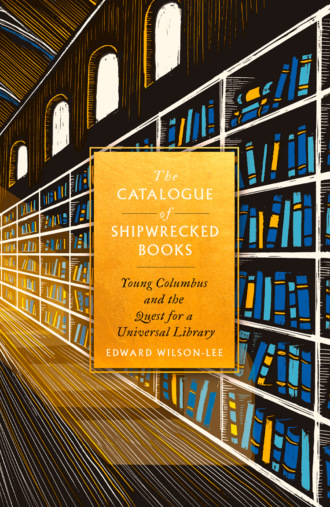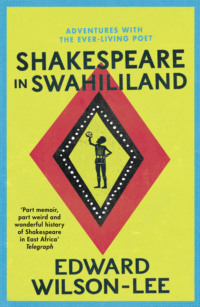
Полная версия
The Catalogue of Shipwrecked Books: Young Columbus and the Quest for a Universal Library


Copyright
William Collins
An imprint of HarperCollinsPublishers
1 London Bridge Street
London SE1 9GF
www.WilliamCollinsBooks.com
This eBook first published in Great Britain by William Collins in 2018
Copyright © Edward Wilson-Lee 2018
Cover illustration by Joe McLaren
Edward Wilson-Lee asserts the moral right to be identified as the author of this work
A catalogue record for this book is available from the British Library
All rights reserved under International and Pan-American Copyright Conventions. By payment of the required fees, you have been granted the non-exclusive, non-transferable right to access and read the text of this e-book on-screen. No part of this text may be reproduced, transmitted, down-loaded, decompiled, reverse engineered, or stored in or introduced into any information storage and retrieval system, in any form or by any means, whether electronic or mechanical, now known or hereinafter invented, without the express written permission of HarperCollins.
Source ISBN: 9780008146221
Ebook Edition © May 2018 ISBN: 9780008146238
Version: 2018-05-04
Dedication
for Kelcey
Contents
Cover
Title Page
Copyright
Dedication
Maps
Epigraph
Prologue: Seville, 12 July 1539
PART I: THE SORCERER’S APPRENTICE
I. The Return from Ocean
II. In the Chamber of Clean Blood
III. The Book of Prophecies
IV. Rites of Passage
V. A Knowledge of Night
PART II: A LANGUAGE OF PICTURES
VI. Shoes & Ships & Sealing Wax
VII. The World City
VIII. The Architecture of Order
IX. An Empire of Dictionaries
PART III: AN ATLAS OF THE WORLD
X. The Devil in the Details
XI. No Place Like Home
XII. Cutting Through
XIII. The Library Without Walls
PART IV: SETTING THINGS IN ORDER
XIV. Another Europe and the Same
XV. The King of Nowhere
XVI. Last Orders
XVII. Epilogue: Ideas on the Shelf
Acknowledgements
A Note on the Life and Deeds of the Admiral
Notes on Sources
Picture Section
List of Illustrations
Index
Also by Edward Wilson-Lee
About the Author
About the Publisher
Maps

The route of Columbus’ Fourth Voyage, 1502–4, on which he was accompanied by Hernando.

Detail of Hernando and Columbus’ route around the Caribbean and Central America in 1502–4.

The route of Hernando’s journey through Europe in 1520–2; the dashed portions are conjectured.

The route of Hernando’s journey through Europe in 1529–31; the dashed portions are conjectured.
Epigraph
Achilles’ shield is therefore the epiphany of Form, of the way in which art manages to construct harmonious representations that establish an order, a hierarchy … Homer was able to construct (imagine) a closed form because he … knew the world he talked about, he knew its laws, causes and effects, and this is why he was able to give it a form. There is, however, another mode of artistic representation, i.e., when we do not know the boundaries of what we wish to portray, when we do not know how many things we are talking about and presume their number to be, if not infinite, then at least astronomically large … The infinity of aesthetics is a sensation that follows from the finite and perfect completeness of the thing we admire, while the other form of representation we are talking about suggests infinity almost physically, because in fact it does not end, nor does it conclude in form. We shall call this representative mode the list, or catalogue.
UMBERTO ECO, The Infinity of Lists
Como todos los hombres de la Biblioteca, he viajado en mi juventud; he peregrinado en busca de un libro, acaso del catálogo de catálogos; ahora que mis ojos casi no pueden descifrar lo que escribo, me preparo a morir a unas pocas leguas del hexágono en que nací.
JORGE LUIS BORGES, ‘El Biblioteca de Babel’
The use of letters was invented for the sake of remembering things, which are bound by letters lest they slip away into oblivion.
ISIDORE OF SEVILLE, Etymologies I.iii
So if the invention of the Shippe was thought so noble, which carryeth riches, and commodities from place to place, and consociateth the most remote regions in participation of their fruits: how much more are letters to be magnified, which as Shippes, passe through the vast Seas of time, and make ages so distant, to participate of the wisdome, illuminations, and inventions the one of the other?
FRANCIS BACON, Advancement of Learning
Конец ознакомительного фрагмента.
Текст предоставлен ООО «ЛитРес».
Прочитайте эту книгу целиком, купив полную легальную версию на ЛитРес.
Безопасно оплатить книгу можно банковской картой Visa, MasterCard, Maestro, со счета мобильного телефона, с платежного терминала, в салоне МТС или Связной, через PayPal, WebMoney, Яндекс.Деньги, QIWI Кошелек, бонусными картами или другим удобным Вам способом.



